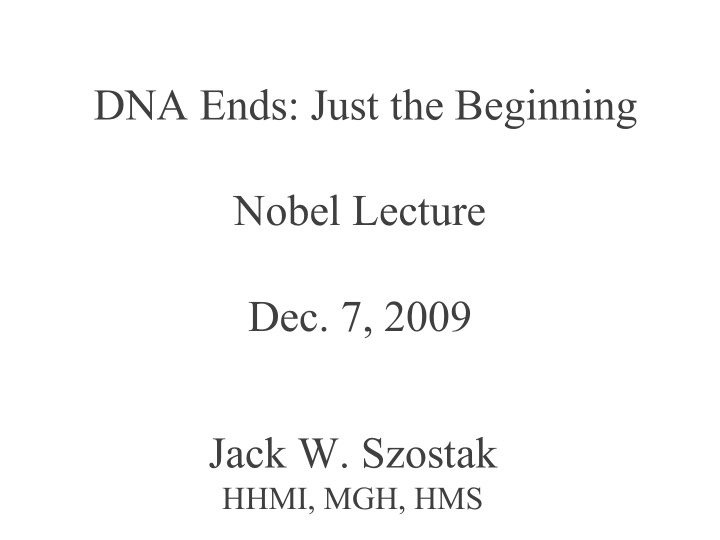



DNA Ends: Just the Beginning Nobel Lecture Dec. 7, 2009 Jack W. Szostak HHMI, MGH, HMS
Two Telomere Problems: 1. DNA ends are reactive 2. Incomplete Replication
Telomeres have been known to be special since the 1930s McClintock, Genetics 26: 234-282 (1941) McClintock, Genetics 23: 315-376 (1938) “ No case was found of the attachment of a piece of one chromosome to the end of another [intact chromosome] ” McClintock, Missouri Agr. Exp. Sta. Res. Bull. 163, 1-48 (1931)
Incomplete Replication of DNA Ends 5 ’ 3 ’ 5 ’ 5 ’ 3 ’ 5 ’ 5 ’ lagging strand is 3 ’ incomplete 5 ’ 3 ’
Setting the stage: Molecular analysis of the reactions of DNA ends.
Non-homologous end-joining in yeast ligation, cut +/- deletion Orr-Weaver and Szostak, PNAS, 1983
Double-strand breaks in DNA stimulate recombination cut abundant recombinants very few recombinants Orr-Weaver et al., PNAS, 1981
Double-strand break repair model for recombination double-strand break resection strand invasion, repair synthesis repair synthesis, branch migration Holliday Junction resolution
Telomeres from Tetrahymena: stable DNA ends that are fully replicated GGGGTT Blackburn and Gall, J. Mol. Biol. 120: 33-53 (1978)
A very special piece of DNA: rDNA: high copy, symmetrical dimer 35S rRNA primary transcript 5’ 3’ (GGGGTT) 50-70 splicing
Tetrahymena telomeres in yeast: A collaborative study to ask whether the biochemistry of telomeres is widely conserved.
Moving Tetrahymena Telomeres into Yeast plasmid cut gene ori t t ori gene Szostak and Blackburn, Cell 29: 245-255 (1982)
Cloning Yeast Telomeres chromosomal DNA y t t ori gene cut y t ori gene ligate t y ori gene Szostak and Blackburn, Cell 29: 245-255 (1982)
A digression: Yeast Artificial Chromosomes
First attempt to make an artificial chromosome CEN gene ORI stable in yeast Tr Tr cut Tr Tr gene CEN ORI unstable in yeast! Murray et al., Nature, 1983
Successful attempt to make an artificial chromosome gene ORI Tr CEN Tr unstable in yeast add extra DNA λ gene ORI λ CEN Tr Tr stable in yeast Murray et al., Nature, 1983
Recombination based models for telomere replication
Telomere Lengthening by Recombination Telomere Lengthening by Repair Synthesis incomplete replication 3 ’ generates 3 ’ overhang strand invasion allows extension of 3 ’ overhang
Telomere Replication by Holliday Junction Resolution 5 ’ 3 ’ 5 ’ 3 ’ 5 ’ 3 ’
telomere maintenance in yeast points to the correct solution
Yeast adds new DNA to Tetrahymena Telomeres t t ori gene t t y y ori gene GGGGTT GGGTGTGGTGTGG Shampay et al., Nature 310: 154-157 (1984)
Correct Structure of Telomeric DNA Ends G-rich 3 ’ -overhang 3 ’ 5 ’
New Model for Telomere Shortening, and the Role of Telomerase in Telomere Maintenance G-rich overhang 5 ’ 3 ’ 5 ’ 5 ’ 3 ’ 3 ’ 5 ’ 5 ’ 3 ’ 3 ’ 5 ’ leading strand is incomplete, 5 ’ 3 ’ but overhang is regenerated by telomerase 3 ’ 5 ’ 5 ’ 3 ’
Cells without telomerase have limited division potential, Cells with telomerase can divide without limit.
Senescence of Yeast EST-1 Cells Lundblad and Szostak, Cell 57: 633-643 (1989)
After telomeres: Directed Evolution of RNA and Protein
Laboratory Evolution of Aptamers An ATP binding RNA molecule Sassanfar and Szostak, Nature 364: 550-553 (1993)
Class I Ribozyme Ligase Bartel and Szostak, Science 261: 1411-1418 (1993)
An HDV ribozyme in the human genome hu rh m d HDV hCPEB3 Salehi-Ashtiani et al., Science , 2006
ATP Binding Protein
Current focus: Origin of Life
Schematic Model of a Protocell A simple cell might be based on a replicating vesicle for compartmentalization, and a replicating genome to encode heritable information. A complex environment provides nucleotides, lipids and various sources of energy. QuickTime™ and a TIFF (Uncompressed) decompressor are needed to see this picture. Mechanical energy (for division), chemical energy (for nucleotide activation), phase transfer and osmotic gradient energy (for growth) may be used by the system. Mansy et al., Nature , 2008
Montmorillonite can bring RNA into Vesicles Hanczyc et al., Science , 2003
Cycles of growth and division Zhu and Szostak, JACS , 2009
Self-Replicating Genetic Polymers It seems likely that informational replication will be achieved in the next decade, and that it will throw new light on the origins of life. Leslie Orgel, 1992
Typical monomer for spontaneous synthesis O N NH O N N NH 2 N N P O O O - NH 2
Typical monomer for spontaneous synthesis and corresponding polymer 2'-NP-DNA O N O N O NH O N N NH 2 NH N N P O O O - O P N O - O O NH 2 NH N O - O P O O NH O - O P O
Origin of Telomerase in Spontaneous Copying Chemistry? 3 ’ 5 ’ 5 ’ 3 ’ activated nucleotides 3 ’ 5 ’ 5 ’ 3 ’ activated nucleotides 3 ’ 5 ’ 5 ’ 3 ’
…and thanks to the many students, postdocs, collaborators, colleagues and friends who made this work possible.
Recommend
More recommend